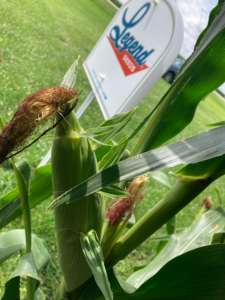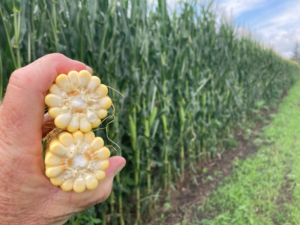Don't Believe These 7 Myths About Conventional Hybrids
 What if you could spend $100 less per bag on seed? How about saving $200—without sacrificing return on investment (ROI)? It may sound like a myth, until you walk two nearby fields planted with the same hybrid of traited corn and conventional corn.
What if you could spend $100 less per bag on seed? How about saving $200—without sacrificing return on investment (ROI)? It may sound like a myth, until you walk two nearby fields planted with the same hybrid of traited corn and conventional corn.
“I’ve been taking a hard look at planting conventional hybrids,” said Scott Eilertson, 44, who farms in southern Minnesota and northern Iowa. “When we walked the fields in early September, I could see the conventional and traited corn hybrids were staying green. The ear quality was about the same, and both had good kernel depth.”
He’s referring to his field of traited corn, which was planted next to a field of conventional corn. Both were the same hybrid. This created a unique opportunity for comparison, since the field of conventional corn is managed by Eilertson’s friend Matt Wangen.
“Matt and I have been friends for a long time,” said Eilertson, who has farmed for 20 years and manages a 50/50 corn soybean operation. “We talk a lot about how we can cut our input costs and still get the best bang for our buck. That’s why I want to run the numbers on conventional versus traited hybrids.”
Wangen has raised conventional hybrids for the past 15 years. The biggest reason he switched to conventional? The cost. “Traited seed is the ‘easy button,’ but it comes at a cost,” said Wangen, who farms near Albert Lea, Minnesota. “What part of the traits add yield? None, because they are all defensive traits. My goal is to make more dollars per acre, so I don’t have to keep farming more acres.”
Why pay that extra $200 a bag?
Wangen and Eilertson work with Mike Parkinson, a key account manager with Legend Seeds. In early September, the three men spent a couple hours walking the side-by-side fields planted with the same Legend Seeds hybrid, with conventional in Wangen’s field, and the same transgenic hybrid in Eilertson’s fields.
The trio evaluated weed control, insect feeding, and how similar the plants and ears looked. Signs of insect pressure were about the same between the conventional hybrids and the traited hybrids, Wangen noted.
Weed control was also good in both fields. “When you walk the fields and don’t see any noticeable differences between the conventional corn and the traited corn, you start asking, ‘Why am I paying that extra $200 a bag for traited corn?’” said Parkinson, who has spoken at a number of ProfitProAG winter conferences.
Busting the myths
Here are seven myths to challenge as you make your seed decisions for the next growing season:
- You can’t produce good yields with conventional hybrids. “I work with growers across the Midwest, and I don’t see conventional hybrids yielding less,” said Parkinson, who serves farmers from Illinois to Minnesota to the Dakotas. “In some cases, the conventional corn out-yields the traited corn. I’ve seen plenty of farmers raising really good corn with conventional hybrids for the past 15 to 20 years.”
A lot of this goes back to “dry and die,” Parkinson added. “In late summer, you see a lot of cornfields go from green to brown instantly around August 27. But you want the corn plants to stay green as long as possible. Fields that die early have about 80% of the kernel depth as the stay-green fields.”
In many cases, hybrids with the “dry and die background” weren’t stellar in 2025, he added. “Dead fields” yielded 150-180 bushels on the good ground, while the ‘green fields’ produced 220 to 245, according to reports from farmers and farm managers.
“That additional yield from hybrids with extra stay-green and improved plant health—both in conventional and traited corn—is amazing,” Parkinson noted. “It’s a great way to improve ROI, and it doesn’t cost extra.”
All this resonates with Wangen, who can remember when traited hybrids were just coming in during the late 1990s. Back then, farmers had to plant refuge acres. Those were areas of non-genetically modified (non-Bt) corn that farmers were legally required to plant alongside their Bt-corn fields. This was an insect resistance management strategy designed to prevent pests like the European corn borer and corn rootworm from developing resistance to the Bt toxins produced by the engineered corn.
“I remember the coffee-shop talk when guys would mention that their best corn was in their refuge acres,” Wangen said. “I started thinking, “Then why are we using these traits?”
- Traited hybrids are the best choice to make crop management easier. Transgenic traits can protect the crop from disease or insects, but they will not increase yield potential, noted the 2023 report “To Go or Not Go With Conventional Hybrids?” from Iowa State University (ISU). Wangen has found this to be true. “Even farmers who plant the traits still use insecticide and fungicide,” he noted.
- Traited hybrids have few drawbacks, other than cost. The biggest challenge from the over-reliance on transgenic hybrids has been the development of resistance, according to ISU. Corn rootworm management has become more problematic. Glyphosate is much less of an all-around herbicide than it once was.
- You need traited seed for effective weed control. A lot of farmers are adamant they need to keep using Roundup®, even though glyphosate resistance has become much more of a challenge, Parkinson said. It goes back to the fear factor, which pushes farmers back into their comfort zone, he noted. “A lot of guys are concerned there will be more weed problems with conventional corn. But the second they see that their conventional corn fields are as clean or cleaner than the fields with traited hybrids, they get it.”
Don’t accept no for an answer regarding weed control in conventional corn, he added. “Any local co-op knows how to control weeds in conventional corn. Don’t let them bluff you.”
Also, look at other management practices beyond chemicals to help control weeds. “I use strip-till and no-till, so I’m not planting weed seeds,” said Wangen, who agrees that Roundup doesn’t work as well as it used to. “I also plant cover crops, which help control waterhemp.”
Younger farmers sometimes ask Wangen how to manage weeds and insects with conventional corn. “I tell them to ask their dad. Everyone planted conventional corn and soybeans 20 or 30 years ago.” [In case you’re wondering, Roundup Ready soybeans hit the market in 1996, followed by Roudup Ready corn in 1998.]
- Spending extra on traited seed is always a good investment. Just how much is that traited seed costing you? “If you buy 500 bags of seed and spend $200 a bag more than you need to, over 10 years you’re approaching $1 million,” Parkinson said. But what will others think if you switch to conventional seed? “I’ve heard farmers say, ‘My neighbor is going to give me crap, or the co-op is going to be upset if I switch to conventional,” Parkinson said. “Remember, it’s your money, not theirs.”
- Where you buy your seed isn’t that big of a deal. Selecting the right seed genetics is the single most important crop management decision you can make, noted the ISU report. “I don’t recommend working with someone who’s just a few months out of college, or someone who has come from an unrelated industry and is now a local ‘seed expert,’” said Parkinson, who has more than 40 years of seed industry experience. “I’m not trying to be harsh, but this is a big decision you don’t want to mess up.”
- Conventional hybrids deliver inferior results. Modern conventional hybrids are more resistant to diseases like tar spot, Goss’s wilt and Southern rust. Biologicals also play a key role in maximizing your seed investment.
 “Thanks to advances in biologicals the last several years, you can take any hybrid and improve it dramatically,” Parkinson said. “That includes better disease resistance, stress tolerance, stay green, root mass size, and nitrogen efficiency—including nitrogen from the air. The farmer, not the plant breeder, has the last say.”
“Thanks to advances in biologicals the last several years, you can take any hybrid and improve it dramatically,” Parkinson said. “That includes better disease resistance, stress tolerance, stay green, root mass size, and nitrogen efficiency—including nitrogen from the air. The farmer, not the plant breeder, has the last say.”
This can be done for significantly less than the cost of traited seed—which helps boost ROI.
“There are so many ways to maximize your seed investment,” Parkinson said. “When you work with an experienced seed professional, you can ‘soup up’ less expensive hybrids and put together a management program for conventional corn that’s pretty much bullet-proof. These are amazing times we’re living in.”
Work with us, maximize your return on investment
Profit ProAG has teamed with Mike Parkinson as a corn hybrid consultant, and he’s ready to work with you. He’ll walk your fields and give you options from multiple genetic platforms.
“When you work with me, you’ll know all the strengths and weaknesses of the hybrids we discuss,” Parkinson said. “Not only will you save on the initial seed cost, but you’ll get the same genetic line as the traited seed. We were successful in our first-year hybrid placements this year, equaling or increasing ROI versus existing suppliers that had been on the farm for generations.”
Wangen appreciates having Parkinson as a resource. “Mike is very intelligent, and I’ve learned a lot from him. A lot of your favorite traited hybrids can be found in conventional. In my experience, planting conventional hybrids just makes sense.”
To learn more, contact Mike Parkinson or your local ProfitProAG representative.
Office – 507-373-2550 / info@profitproag.com
Dr. Jim Ladlie – 507-383-1325 / jladlie@profitproag.com
Dennis Klockenga – 320-333-1608 / dklockenga@profitproag.com
Chris Chodur – 507-402-4195 / cchodur@profitproag.com
